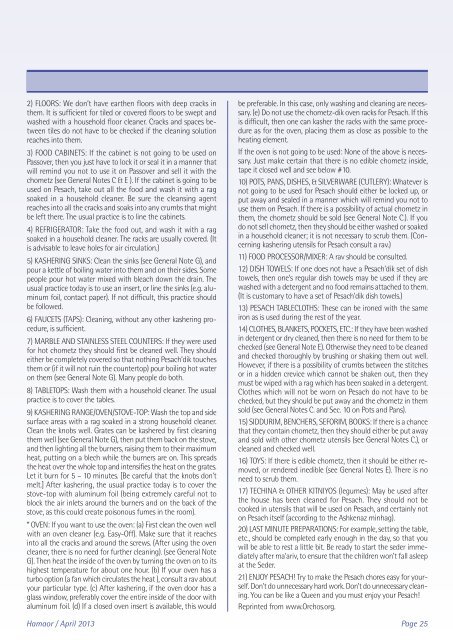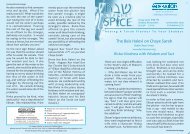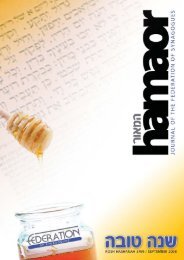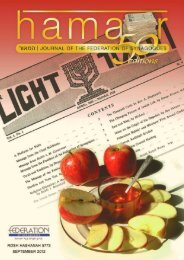Pesach 5773 - 18/03/2013 - Federation Of Synagogues
Pesach 5773 - 18/03/2013 - Federation Of Synagogues
Pesach 5773 - 18/03/2013 - Federation Of Synagogues
You also want an ePaper? Increase the reach of your titles
YUMPU automatically turns print PDFs into web optimized ePapers that Google loves.
2) FLOORS: We don’t have earthen floors with deep cracks in<br />
them. It is sufficient for tiled or covered floors to be swept and<br />
washed with a household floor cleaner. Cracks and spaces between<br />
tiles do not have to be checked if the cleaning solution<br />
reaches into them.<br />
3) FOOD CABINETS: If the cabinet is not going to be used on<br />
Passover, then you just have to lock it or seal it in a manner that<br />
will remind you not to use it on Passover and sell it with the<br />
chometz (see General Notes C & E ). If the cabinet is going to be<br />
used on <strong>Pesach</strong>, take out all the food and wash it with a rag<br />
soaked in a household cleaner. Be sure the cleansing agent<br />
reaches into all the cracks and soaks into any crumbs that might<br />
be left there. The usual practice is to line the cabinets.<br />
4) REFRIGERATOR: Take the food out, and wash it with a rag<br />
soaked in a household cleaner. The racks are usually covered. (It<br />
is advisable to leave holes for air circulation.)<br />
5) KASHERING SINKS: Clean the sinks (see General Note G), and<br />
pour a kettle of boiling water into them and on their sides. Some<br />
people pour hot water mixed with bleach down the drain. The<br />
usual practice today is to use an insert, or line the sinks (e.g. aluminum<br />
foil, contact paper). If not difficult, this practice should<br />
be followed.<br />
6) FAUCETS (TAPS): Cleaning, without any other kashering procedure,<br />
is sufficient.<br />
7) MARBLE AND STAINLESS STEEL COUNTERS: If they were used<br />
for hot chometz they should first be cleaned well. They should<br />
either be completely covered so that nothing <strong>Pesach</strong>’dik touches<br />
them or (if it will not ruin the countertop) pour boiling hot water<br />
on them (see General Note G). Many people do both.<br />
8) TABLETOPS: Wash them with a household cleaner. The usual<br />
practice is to cover the tables.<br />
9) KASHERING RANGE/OVEN/STOVE-TOP: Wash the top and side<br />
surface areas with a rag soaked in a strong household cleaner.<br />
Clean the knobs well. Grates can be kashered by first cleaning<br />
them well (see General Note G), then put them back on the stove,<br />
and then lighting all the burners, raising them to their maximum<br />
heat, putting on a blech while the burners are on. This spreads<br />
the heat over the whole top and intensifies the heat on the grates.<br />
Let it burn for 5 – 10 minutes. [Be careful that the knobs don't<br />
melt.] After kashering, the usual practice today is to cover the<br />
stove-top with aluminum foil (being extremely careful not to<br />
block the air inlets around the burners and on the back of the<br />
stove, as this could create poisonous fumes in the room).<br />
* OVEN: If you want to use the oven: (a) First clean the oven well<br />
with an oven cleaner (e.g. Easy-<strong>Of</strong>f). Make sure that it reaches<br />
into all the cracks and around the screws. (After using the oven<br />
cleaner, there is no need for further cleaning). (see General Note<br />
G). Then heat the inside of the oven by turning the oven on to its<br />
highest temperature for about one hour. (b) If your oven has a<br />
turbo option (a fan which circulates the heat ), consult a rav about<br />
your particular type. (c) After kashering, if the oven door has a<br />
glass window, preferably cover the entire inside of the door with<br />
aluminum foil. (d) If a closed oven insert is available, this would<br />
Hamaor / April <strong>2013</strong><br />
be preferable. In this case, only washing and cleaning are necessary.<br />
(e) Do not use the chometz-dik oven racks for <strong>Pesach</strong>. If this<br />
is difficult, then one can kasher the racks with the same procedure<br />
as for the oven, placing them as close as possible to the<br />
heating element.<br />
If the oven is not going to be used: None of the above is necessary.<br />
Just make certain that there is no edible chometz inside,<br />
tape it closed well and see below #10.<br />
10) POTS, PANS, DISHES, & SILVERWARE (CUTLERY): Whatever is<br />
not going to be used for <strong>Pesach</strong> should either be locked up, or<br />
put away and sealed in a manner which will remind you not to<br />
use them on <strong>Pesach</strong>. If there is a possibility of actual chometz in<br />
them, the chometz should be sold (see General Note C.). If you<br />
do not sell chometz, then they should be either washed or soaked<br />
in a household cleaner; it is not necessary to scrub them. (Concerning<br />
kashering utensils for <strong>Pesach</strong> consult a rav.)<br />
11) FOOD PROCESSOR/MIXER: A rav should be consulted.<br />
12) DISH TOWELS: If one does not have a <strong>Pesach</strong>’dik set of dish<br />
towels, then one’s regular dish towels may be used if they are<br />
washed with a detergent and no food remains attached to them.<br />
(It is customary to have a set of <strong>Pesach</strong>’dik dish towels.)<br />
13) PESACH TABLECLOTHS: These can be ironed with the same<br />
iron as is used during the rest of the year.<br />
14) CLOTHES, BLANKETS, POCKETS, ETC.: If they have been washed<br />
in detergent or dry cleaned, then there is no need for them to be<br />
checked (see General Note E). Otherwise they need to be cleaned<br />
and checked thoroughly by brushing or shaking them out well.<br />
However, if there is a possibility of crumbs between the stitches<br />
or in a hidden crevice which cannot be shaken out, then they<br />
must be wiped with a rag which has been soaked in a detergent.<br />
Clothes which will not be worn on <strong>Pesach</strong> do not have to be<br />
checked, but they should be put away and the chometz in them<br />
sold (see General Notes C. and Sec. 10 on Pots and Pans).<br />
15) SIDDURIM, BENCHERS, SEFORIM, BOOKS: If there is a chance<br />
that they contain chometz, then they should either be put away<br />
and sold with other chometz utensils (see General Notes C.), or<br />
cleaned and checked well.<br />
16) TOYS: If there is edible chometz, then it should be either removed,<br />
or rendered inedible (see General Notes E). There is no<br />
need to scrub them.<br />
17) TECHINA & OTHER KITNIYOS (legumes): May be used after<br />
the house has been cleaned for <strong>Pesach</strong>. They should not be<br />
cooked in utensils that will be used on <strong>Pesach</strong>, and certainly not<br />
on <strong>Pesach</strong> itself (according to the Ashkenaz minhag).<br />
20) LAST MINUTE PREPARATIONS: For example, setting the table,<br />
etc., should be completed early enough in the day, so that you<br />
will be able to rest a little bit. Be ready to start the seder immediately<br />
after ma’ariv, to ensure that the children won’t fall asleep<br />
at the Seder.<br />
21) ENJOY PESACH! Try to make the <strong>Pesach</strong> chores easy for yourself.<br />
Don’t do unnecessary hard work. Don’t do unnecessary cleaning.<br />
You can be like a Queen and you must enjoy your <strong>Pesach</strong>!<br />
Reprinted from www.Orchos.org.<br />
Page 25










